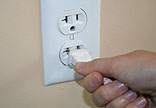Electronic Equipment
Plugs and Adapters
The U.S. runs on a 120-volt AC 60 Hz electricity system. Unless your appliance is designed for this voltage and frequency, you will need a transformer.
Your appliance may be capable of running at 120V, 60Mhz AC, however if it was purchased outside the U.S., you will probably need a plug adapter to fit your appliance into a standard American outlet. An adapter is not a transformer, simply a device that changes the shape of your plug so that it can fit into American outlets.
Power sockets in North America are different from those used in many other parts of the world. Modern U.S. wall sockets accept the two following types of plug:
Your appliance may be capable of running at 120V, 60Mhz AC, however if it was purchased outside the U.S., you will probably need a plug adapter to fit your appliance into a standard American outlet. An adapter is not a transformer, simply a device that changes the shape of your plug so that it can fit into American outlets.
Power sockets in North America are different from those used in many other parts of the world. Modern U.S. wall sockets accept the two following types of plug:

Japanese-style plug with two perpendicular flat blades.
American-style plug with two perpendicular flat blades above a circular grounding pin.
Videos and DVDs
The U.S. uses the NTSC system, which is not compatible with PAL or SECAM, for videos, and "Region 1" for DVDs. Many DVDs and videos purchased abroad do not work on U.S. players or readers. DVD players are inexpensive in the U.S; basic models are less than $100.
Every neighborhood in Los Angeles has at least one DVD/video rental store. In addition, Netflix (www.netflix.com) is a popular DVD rent-by-mail service. For $9.99 and up per month, you can rent as many DVDs as you like.
Every neighborhood in Los Angeles has at least one DVD/video rental store. In addition, Netflix (www.netflix.com) is a popular DVD rent-by-mail service. For $9.99 and up per month, you can rent as many DVDs as you like.
Modems
The U.S. uses a standard North America RJ-11 phone jack, which is different from those used in many other countries. That means you may need a phone line adapter, in addition to an electrical adapter, to use your modem.
Check Steve Kropla's "Help for World Travelers" Web site (www.kropla.com) for a comprehensive listing of worldwide electrical and telephone information, including a useful guide to hooking up your laptop's modem.
Check Steve Kropla's "Help for World Travelers" Web site (www.kropla.com) for a comprehensive listing of worldwide electrical and telephone information, including a useful guide to hooking up your laptop's modem.

